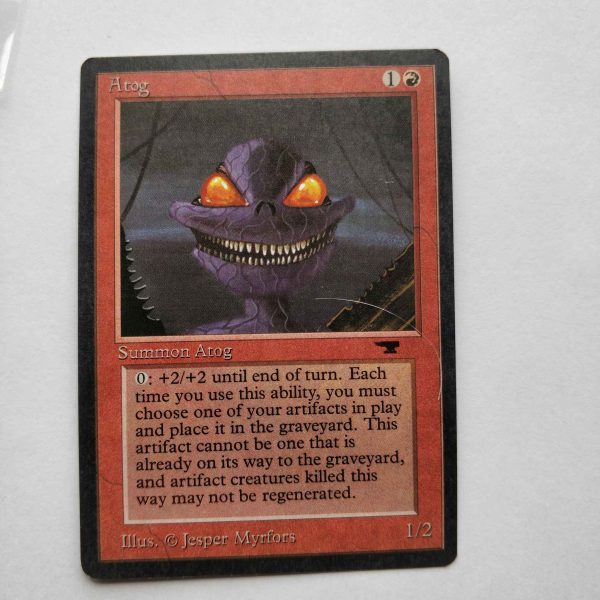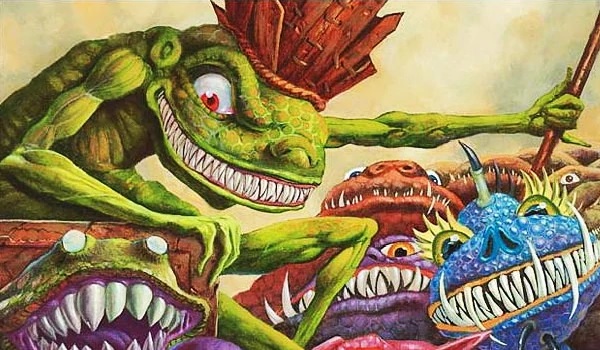Are you a Quiet Speculation member?
If not, now is a perfect time to join up! Our powerful tools, breaking-news analysis, and exclusive Discord channel will make sure you stay up to date and ahead of the curve.
In the last article, we introduced the matter of this new series, which is going to deal with those creature types that are unique to the Magic: The Gathering franchise. Today, we’ll really get into it! As this is meant as a journey throughout the history of Magic expansions, we’ll proceed in chronological order.
The first set introducing a creature type invented especially for Magic is Antiquities, which in fact introduced two. Let’s take a closer look at this set, just to have an overview of the context in which some unique creatures were born.
Antiquities
Released on March 4, 1994, Antiquities is among the first expansion sets of Magic, second only to Arabian Nights. It’s the first Magic set to put an emphasis on artifacts. This would happen several other times in the future, but none of the following sets would feature such a strong presence of artifacts. Think of Urza’s Saga (1998), Mirrodin (2003), Scars of Mirrodin (2010), and Kaladesh (2016). All of them gave importance to artifacts, but Antiquities was on another level entirely, as every single card either was an artifact or mentioned artifacts.

Considering that, it's unsurprising that both creature types invented for this set have something to do with artifacts. Those creatures are Atog and Tetravite. They are not the only two creature types that were added to the game with Antiquities, of course. In fact, half of the creature types present in this set were new at the time. For instance, we had the first example of Druid, and a few other types that would be changed later (Archaeologist, Gremlin and so on). However, only Atog and Tetravite are species unique to this game, and this is why we’ll dissect them as part of this series.
The Origins of Atogs
The first creature with the type Atog appeared in Antiquities, and it was then reprinted in a few core sets and in Mirrodin. It was simply called Atog, probably because at first, they weren’t planning to create more. Over the following years, however, additional flavors of Atog were printed, and today we have no less than twelve! So what exactly is an atog?
Four more atogs
Well, first of all, the story goes that the word “atog” was invented as an anagram of the word “goat”. The joke is that atogs, just as goats, would eat almost anything. Magic is no stranger to cracking these sorts of jokes: see Phelddagrif (Garfield PhD) and Pemmin's Aura (I am Superman).
Atogs' Shape and Habits
As for their appearance, atogs have humanoid shapes and reptilian vibes. They also have enormous mouths with scary teeth, signalling that insatiable hunger is their most peculiar trait. In fact, when you look at the text box, every Atog ever printed has an ability that demands some sort of feeding. And so does the flavor text, which always refers to meals and the action of eating.
After the original Atog from Antiquities, four more were added in the next couple of years. With Mirage came Foratog, with Visions came Chronatog, with Weatherlight came Necratog, and finally, with Tempest came Auratog. So, by the end of 1997, five Atogs existed, one for each color. They all shared some similarities: the mana value was always 2 or 3, their stats were all 1/2, and they each had an activated ability to pump themselves.
The Evolution of Atog
But that’s not all: remember, we have twelve Atogs. Odyssey (2001) contained no fewer than six new ones. And they were all multicolored! It looks like the original five Atogs have been breeding, as the new five resemble their parents… but what about the sixth?
That's the Atogatog, a very special sort of lord which feasts on its own kind. “It relishes old-fashioned family meals,” as the flavor text goes.
Atogs from Odyssey onwards
Last but not least, let’s fast-forward to Mirrodin (2003), where the final Atog was printed. The balance of colors was just perfect, until Megatog came out, shifting the balance toward red. After all, we are now on one of the most heavily artifact-based sets ever, so why not creating an evolved (and gigantic) relative of Atog?
Megatog also has the power to sacrifice artifacts for gaining pump, but in this case it gets +3/+3 and trample. To quote another great flavor text, "In an ironic bit of evolution, the megatog's dozens of teeth are mainly ornamental. It prefers swallowing things whole."
And don't forget of Chronatog Totem! It's not really an Atog (in fact, it's not even a creature), but an artifact whose ability allows it to turn into Chronatog until the end of turn. Ah, Time Spiral.
Tetravites and the Like
Enough with atogs: it's time to move to the second unique creature type that was introduced with Antiquities via Tetravite. This time, it's a weird type, as it only appears on tokens. Not only that, it also appears on token created by a very specific creature, called Tetravus. Tetravus was created a simple artifact creature, with no type, but later got the type construct. Nothing special here: as we saw in the last installment, Magic developers have been trying to streamline creature types for quite a while.
Tetravus and its cousins
There is not much to be said about Tetravus, except for the fact that it was called back to twice in the course of Magic's history. In 2003, with Mirrodin, a card called Pentavus was printed. Its name, which contains the number "five" just as Tetravus contained the number "four," is a clear reference to the construct from Antiquities. And so is its ability to create tokens, or Pentavites.
In 2006, with Time Spiral, a third construct with a similar ability arrived: Triskelavus and its own tokens, this time called Triskelavites. Again, there's a number in the name of the card (three), but this time the reference is double, as it also recalls Triskelion.
A Pattern of -Avus and -Avites
All of these three creatures are constructs which enter the battlefield with a number of +1/+1 counters. At the beginning of your upkeep, pilots may remove any number of counters and create that many 1/1 tokens. They may also exile any number of tokens created this way and put back that many counters on the original creature. Only Triskelavus is a bit different. It allows players to sacrifice the tokens and deal damage, but not to put counters back onto their construct.
None of these three creature types appear on any printed creature, then. They can only be created as tokens. However, they are still creature types, which means Mistform Ultimus, as well as any creature with the ability Changeling, will also be Tetravite, Pentavite, and Triskelavite.
Flavor and Rules
In the course of this installment, we began analyzing some creatures unique to the Magic franchise. As far as I'm concerned, they all show interesting designs, especially as they combine new concepts of creatures with sensible abilities. It's hard to say whether designers had the rules in mind and then created suitable concepts, or the other way around. Anyway, it worked very well, particularly with atogs!
Stay tuned for the next piece, where we'll move on to the third Magic expansion, Legends. What new creatures did this set offer? Did you know that it contains a creature that would only become famous thirteen years later? Let me know what you think in the comments. And while we're at it... team Atog, or team Tetravite?





